The AMD Ryzen 5 2500X and Ryzen 3 2300X CPU Review
by Ian Cutress on February 11, 2019 11:45 AM ESTCPU Performance: Web and Legacy Tests
While more the focus of low-end and small form factor systems, web-based benchmarks are notoriously difficult to standardize. Modern web browsers are frequently updated, with no recourse to disable those updates, and as such there is difficulty in keeping a common platform. The fast paced nature of browser development means that version numbers (and performance) can change from week to week. Despite this, web tests are often a good measure of user experience: a lot of what most office work is today revolves around web applications, particularly email and office apps, but also interfaces and development environments. Our web tests include some of the industry standard tests, as well as a few popular but older tests.
We have also included our legacy benchmarks in this section, representing a stack of older code for popular benchmarks.
All of our benchmark results can also be found in our benchmark engine, Bench.
WebXPRT 3: Modern Real-World Web Tasks, including AI
The company behind the XPRT test suites, Principled Technologies, has recently released the latest web-test, and rather than attach a year to the name have just called it ‘3’. This latest test (as we started the suite) has built upon and developed the ethos of previous tests: user interaction, office compute, graph generation, list sorting, HTML5, image manipulation, and even goes as far as some AI testing.
For our benchmark, we run the standard test which goes through the benchmark list seven times and provides a final result. We run this standard test four times, and take an average.
Users can access the WebXPRT test at http://principledtechnologies.com/benchmarkxprt/webxprt/

WebXPRT 2015: HTML5 and Javascript Web UX Testing
The older version of WebXPRT is the 2015 edition, which focuses on a slightly different set of web technologies and frameworks that are in use today. This is still a relevant test, especially for users interacting with not-the-latest web applications in the market, of which there are a lot. Web framework development is often very quick but with high turnover, meaning that frameworks are quickly developed, built-upon, used, and then developers move on to the next, and adjusting an application to a new framework is a difficult arduous task, especially with rapid development cycles. This leaves a lot of applications as ‘fixed-in-time’, and relevant to user experience for many years.
Similar to WebXPRT3, the main benchmark is a sectional run repeated seven times, with a final score. We repeat the whole thing four times, and average those final scores.
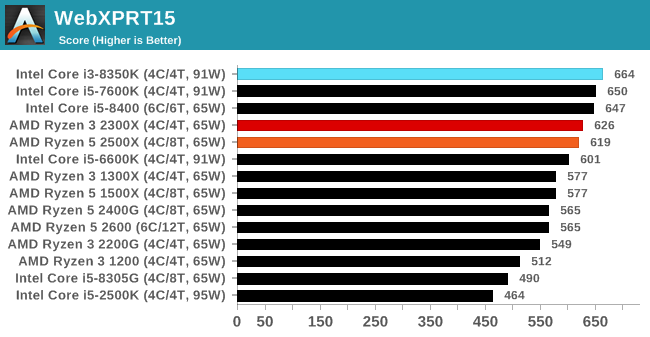
Speedometer 2: JavaScript Frameworks
Our newest web test is Speedometer 2, which is a accrued test over a series of javascript frameworks to do three simple things: built a list, enable each item in the list, and remove the list. All the frameworks implement the same visual cues, but obviously apply them from different coding angles.
Our test goes through the list of frameworks, and produces a final score indicative of ‘rpm’, one of the benchmarks internal metrics. We report this final score.
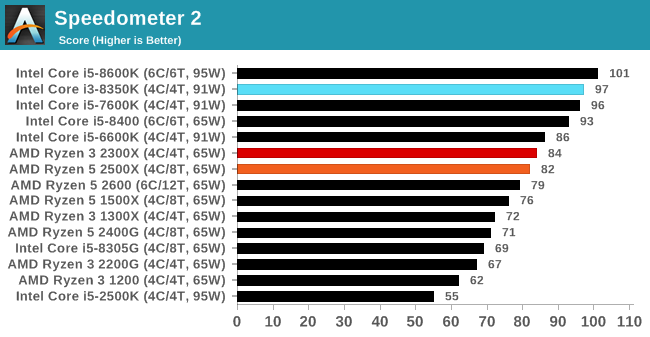
Google Octane 2.0: Core Web Compute
A popular web test for several years, but now no longer being updated, is Octane, developed by Google. Version 2.0 of the test performs the best part of two-dozen compute related tasks, such as regular expressions, cryptography, ray tracing, emulation, and Navier-Stokes physics calculations.
The test gives each sub-test a score and produces a geometric mean of the set as a final result. We run the full benchmark four times, and average the final results.
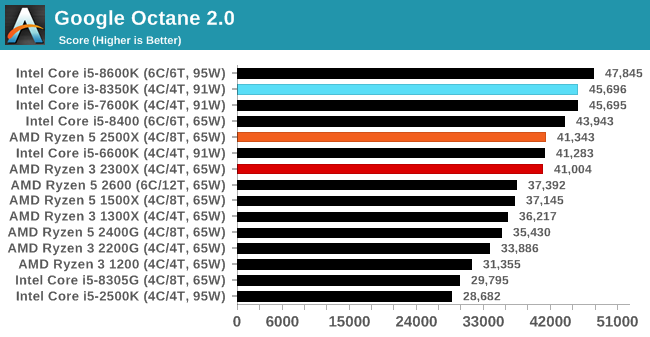
Mozilla Kraken 1.1: Core Web Compute
Even older than Octane is Kraken, this time developed by Mozilla. This is an older test that does similar computational mechanics, such as audio processing or image filtering. Kraken seems to produce a highly variable result depending on the browser version, as it is a test that is keenly optimized for.
The main benchmark runs through each of the sub-tests ten times and produces an average time to completion for each loop, given in milliseconds. We run the full benchmark four times and take an average of the time taken.
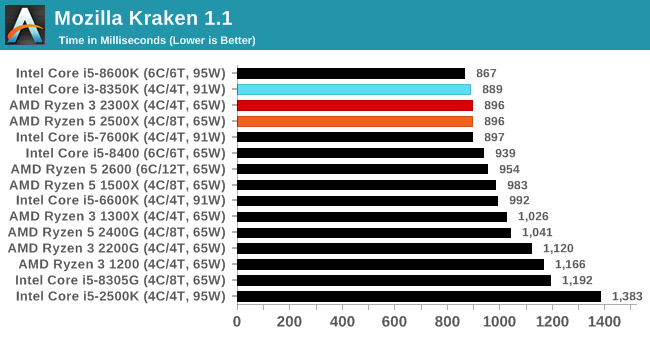
3DPM v1: Naïve Code Variant of 3DPM v2.1
The first legacy test in the suite is the first version of our 3DPM benchmark. This is the ultimate naïve version of the code, as if it was written by scientist with no knowledge of how computer hardware, compilers, or optimization works (which in fact, it was at the start). This represents a large body of scientific simulation out in the wild, where getting the answer is more important than it being fast (getting a result in 4 days is acceptable if it’s correct, rather than sending someone away for a year to learn to code and getting the result in 5 minutes).
In this version, the only real optimization was in the compiler flags (-O2, -fp:fast), compiling it in release mode, and enabling OpenMP in the main compute loops. The loops were not configured for function size, and one of the key slowdowns is false sharing in the cache. It also has long dependency chains based on the random number generation, which leads to relatively poor performance on specific compute microarchitectures.
3DPM v1 can be downloaded with our 3DPM v2 code here: 3DPMv2.1.rar (13.0 MB)
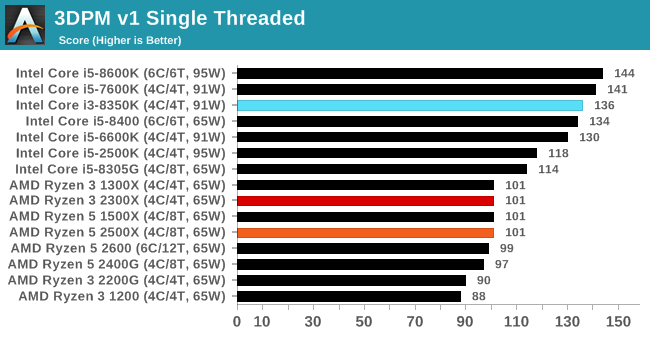
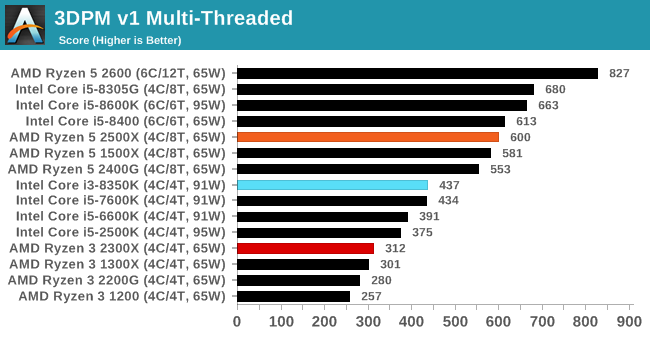
x264 HD 3.0: Older Transcode Test
This transcoding test is super old, and was used by Anand back in the day of Pentium 4 and Athlon II processors. Here a standardized 720p video is transcoded with a two-pass conversion, with the benchmark showing the frames-per-second of each pass. This benchmark is single-threaded, and between some micro-architectures we seem to actually hit an instructions-per-clock wall.
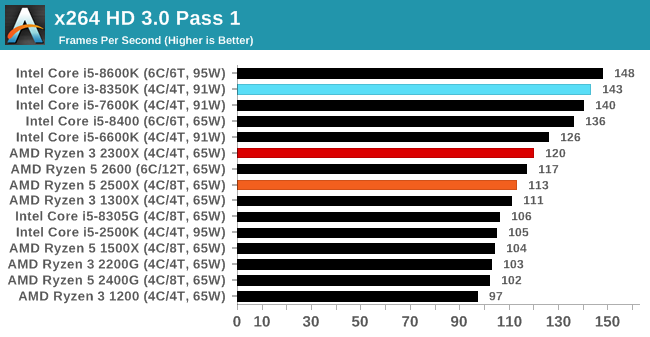
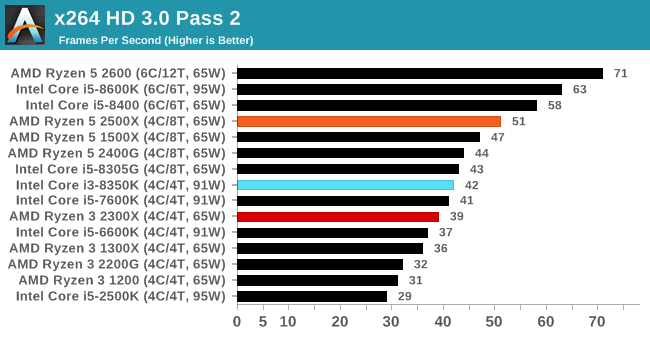










65 Comments
View All Comments
Korguz - Monday, February 11, 2019 - link
Phynazbetter then the typical Intel.. overpriced, and not much gained
MDD1963 - Monday, February 11, 2019 - link
How many folks with GTX1080s would be using either of these CPUs tested (even if they were for sale)? :)Allan_Hundeboll - Tuesday, February 12, 2019 - link
Gamers on a budgetmikato - Thursday, April 4, 2019 - link
Someone that decided to start gaming, or changed to a game that required more graphics power so bought a graphics card. Maybe a kid whose parents bought a computer, or a hand-me-down computer. Even I have been gaming and building computers a long time and I have upgraded the graphics card on my computers several times around the middle of that system's lifetime (I keep them pretty long). I have friends that play WoW and needed to upgrade.There are plenty of situations.Have you seen gaming benchmarks with low end CPUs vs high end CPUs when both have the same high end graphics card?
Ethnipod - Monday, February 11, 2019 - link
wrong power consumption test ...Ryzen 5 2500X get DDR4 2933 (1.3 V) vs coffe lake DDR4 2667 (1.2 V).
(for Ryzen 5 2500X clock up ram freq to 3200, or downclock to 2667)
ty and sorry for my eng.
pajuk - Monday, February 11, 2019 - link
another intel biased review . Why didint youput the price of the i5-8600k like in other reviews??maybe because you know that it costs the same as amd 2700 ??? tired of LIARS.
Korguz - Monday, February 11, 2019 - link
prove it.. post some links...Irata - Tuesday, February 12, 2019 - link
The statement by Pajuk is actually not correct - the i5-8600k costs $288.96 boxed, the Ryzen 7 2700 229.99 - both at Newegg - so it's not the same price but $60 more.pajuk - Tuesday, February 12, 2019 - link
https://www.pcdiga.com/processador-amd-ryzen-7-270...https://www.pcdiga.com/processador-intel-core-i5-8...
pajuk - Tuesday, February 12, 2019 - link
you help me even more, this LIARS in anadtech are as bad as tomshardware.